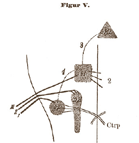

Chris Majors is an artist with an unusual mission: He produces digital artworks that contain such high resolution and such a large number of colors that normal printers — which can handle 16 million possible colors — cannot print them. Apparently he’s written his own program to generate the images, and if you order at the largest possible print size — 8 feet by 4 feet — it’ll take him 10 days to render the image, using a 2.2 GHz computer. As he notes:
The resolution of the images: With a minimum of 2,8 billion calculated points (at 34x34 in.) the finest details can be fully appreciated, even with a magnifying glass. Because these drawings exist only in very large sizes with extremely detailed subjects, a profusion of views appears as one approaches them.
Extremely cool! But unfortunately, also extremely ugly. Man, why is neato conceptual art always so totally hideous? This stuff looks like the side of a van.
(Thanks to Ted Rainer for this one!)

Dig it: Songbirds have a concept of grammar. Timothy Gentner, a scientist at the University of California at San Diego, recently took some European songbirds and trained them to recognize a normal segment of birdsong versus one with a “clause” in the middle. As the BBC reports:
Of the 11 songbirds tested, nine were able to pick out the inserted phrases about 90 per cent of the time, the team reports in Thursday’s issue of the journal Nature.
Similar experiments on tamarin monkeys showed the primates could not recognize recursive grammar.
“An intriguing possibility is that the capacity to recognize recursion might be found only in species that can acquire new patterns of vocalization, for example, songbirds, humans and perhaps some cetaceans,” psychologist Gary Marcus of the University of New York wrote in a journal commentary accompanying the study.
This contradicts Noam Chomsky’s idea of “innate” grammar — which holds that grammar is something only humans possess, a mental capacity that emerges at a certain point in brain development, almost the way water crystallizes into ice at zero degrees. But as it turns out, songbirds have some wicked-cool abilities to distinguish variants of song, many of which also suggest an innate grammar. For example: Male zebra finches learn their songs from their fathers. When they’re exposed to taped songs from their own and other species, they wind up singing ones specific to their species. Something inside their brains is doing a bit of filtering. (For details, check page 348 of this great summary of songbird neurophysiology.)
(Thanks to Erik Weissengruber for this one!)

Few people know this, but Sigmund Freud began his career with some rather humble work: Dissecting eel testicles. Nonetheless, he was a skilled lab researcher, and produced painstakingly careful drawings of what he found. When he later began studying human brain function, he drew equally detailed pictures of neurons and their connecting fibers.
But then something happened: Freud became more interested in the psyche — an artifact that is intangible, and thus cannot literally be drawn. His sketches became increasingly abstract; they looked less like photographs and more like the wiring schematics for a circuit — as with this illustration, above, of the human auditory system. Then, as the New York Times reports in this week’s Science section, came one particularly historic sketch:
In … an unpublished essay titled, “Introduction to Neuropathology,” looping lines connect several nodes in a diagram intended to show how areas of the brain represent the body, arms, face, hands.
“It is no exaggeration to say that this insight is the precise point at which the mind — that aspect of the organism which represents the body not concretely but rather functionally, abstractly and symbolically — entered Freud’s scientific work,” Mark Solms wrote in a commentary that accompanies the drawings.
Cool, eh? It reminds me one of my big obsessions: That your tools help determine how you think. So long as Freud used realistic modes of drawing, he was hemmed in by the dictates of straightforward physiology. To ponder the abstracts of human behavior, he needed to turn to abstract comix. Of course, there are plenty of people today who probably wish he’d stayed dissecting eel testicles instead of pondering the psychic traumas of bourgeoise ladies in Vienna, heh. Anyway, Freud’s drawings are on display beginning May 11 at the New York Academy of Medicine. I’m going to go check them out!

Wired News has just published my latest column — and this one is a new theory about why Lara Croft so appeals to young men. I suggest that it’s not just about her humungous ta-tas, but something much odder: The penchant of young teenage boys to viscerally — and covertly — identify with young women in peril.
I base this on a re-reading of Carol Clover’s famous essay on the appeal of slasher movies and the “Final Girl”. But since I’m basically suggesting that the sexuality of young men is kinda fluid, I have recieved about 4,000 emails from gamers stating that “dude I totally luv lara croft but I totally AM NOT GAY”. Heh.
Anyway, the column is both online at Wired News here, and archived below!
How Lara Croft Steals Hearts
by Clive ThompsonLara Croft’s back and she’s as bodacious as ever. In the new Tomb Raider: Legend, Eidos has crafted its heroine using its usual blend of Indiana Jones and Victoria’s Secret. As she runs through the catacombs, Croft’s spectacular chest heaves and her behind wiggles. In quiet moments between action sequences, she stretches up on tiptoes and arches her back, to get the kinks out. Ahem.
She’s a piece of cheesecake, all right. And among cultural pundits, this is the prevailing wisdom about why young men so loved Tomb Raider when it debuted in 1996. Teenage boys are horny; teenage boys like to ogle hot women; Tomb Raider allowed them to drool over Croft for hours on end. This dismal equation, as the theory goes, also explains the subsequent explosion of games with hot-chick characters, from Bloodrayne to the undulating mass of Tecmo’s Dead or Alive vixens. Once again, the basest urges of young men had coarsened society — right?
I beg to differ. I think young boy gamers loved Lara for reasons that were considerably stranger. They weren’t just ogling her: They were identifying with her. Playing the role of a hot, sexy woman in peril — surrounded by violence on all sides — was, unexpectedly, a totally electric experience for young guys.
I am not merely pulling this argument out of my butt. I’m basing it on a famous piece of film theory: the “Final Girl” concept of slasher movies.

This Sunday, the New York Times Magazine will publish my latest feature for them: It’s called “The Big Disconnect”, and it’s about the highly-fraught question of the Internet in China. It focuses closely on Google’s decision to open up shop there, but I tried also to give a closer picture of what the Internet means to the new generation of young Chinese high-tech users.
The Times has put up an advance copy of the piece on its web site, so you can read the entire thing there now! I’ve also archived a permanent free copy below.
I also have some observations about China and the Internet that couldn’t fit into the piece, and when I get time free this weekend I’m hoping to blog about them a bit.
Here’s a teaser to whet your apetite:
One mistake Westerners frequently make about China is to assume that the government is furtive about its censorship. On the contrary, the party is quite matter of fact about it — proud, even. One American businessman who would speak only anonymously told me the story of attending an award ceremony last year held by the Internet Society of China for Internet firms, including the major Internet service providers. “I’m sitting there in the audience for this thing,” he recounted, “and they say, ‘And now it’s time to award our annual Self-Discipline Awards!’ And they gave 10 companies an award. They gave them a plaque. They shook hands. The minister was there; he took his picture with each guy. It was basically like Excellence in Self-Censorship — and everybody in the audience is, like, clapping.” Internet censorship in China, this businessman explained, is presented as a benevolent police function. In January, the Shenzhen Public Security Bureau created two cuddly little anime-style cartoon “Internet Police” mascots named “Jingjing” and “Chacha”; each cybercop has a blog and a chat window where Chinese citizens can talk to them. As a Shenzhen official candidly told The Beijing Youth Daily, “The main function of Jingjing and Chacha is to intimidate.” The article went on to explain that the characters are there “to publicly remind all Netizens to be conscious of safe and healthy use of the Internet, self-regulate their online behavior and maintain harmonious Internet order together.”
Click on “more” below to read the whole piece!

Man, is this something I wish I was around to see: The annual ascendance of the bioluminescent Firefly Squid of Toyama Bay. Apparently the squid — which are normally rather reclusive — mass near the surface from March to June for their spawning season. According to a Toyama web site, the function of the squid’s biochemisty is unknown:
Glowing like blue-green gems, female firefly squid, approximately seven centimeters in length, shed light from around a thousand tiny light-producing organs located in the skin at the ends of their tentacles, around their eyes, and on their bodies (their mantles). It is speculated that this phosphorescence disguises the animal’s outline, or perhaps serves to intimidate or confuse potential predators. Other hypotheses for this phenomenon include the theory that the light attracts prey, or alternatively that it serves to distinguish the sexes.
Imagine a tank of those things in your apartment at night!
(Thanks to El Rey for this one!)
Everyone knows how college students will try to make themselves sound smarter by reaching for the thesaurus and using big, ponderous words they barely understand. But now a new study shows that readers can see through this. Daniel Oppenheimer, a psychologist at Princeton, took a handful of writing samples and used a thesaurus to replace the simple words with needlessly flowery ones. As the Bad Language blog notes:
He created a “highly complex” version of each original text by replacing each noun, verb and adjective in it with the longest synomym. This is the kind of writing by thesaurus that many business people and techies employ when they want to sound knowledgeable and important or because they think writing like they speak will make them sound lightweight.
Then Oppenheimer gave all the writing samples — the original, simple ones and the modified, flowery ones — to 71 students to evaluate. The result? As the grandiosity and complexity of the language increased, the judges’ estimation of the intelligence of the authors decreased. Oppenheimer wrote up his results in a paper with the gorgeously ironic title “Consequences of Erudite Vernacular Utilized Irrespective of Necessity: Problems with Using Long Words Needlessly.”
His findings make perfect sense when you think about the nature of language. Every sentence and paragraph of writing is an organic whole; a writer’s style is, too. Taking a sentence and swapping in synonyms plucked from a thesaurus is bound to warp the meaning and clarity of a sentence, because synonyms are not mathematical equals: They all have slightly different shadings. Describe someone as “angry” and it means one thing; describe them as “choleric” or “furious” or “splenetic” — all synonyms offered up by Thesaurus.com — and you’re saying something slightly different. When an essay is filled with these sort of swapped-in synonyms, it winds up having Frankensteinian seams: You can feel its cognitive artificiality, its constipated straining to convey a higher meaning. No wonder the judges thought these essays seemed dumber.

I’m coming late to this, but Wired New recently published my latest video-game column. In this one, I defend the undefensible: The joys of highly violent first-person shooters. You can read it online here, or find the archived copy below!
The Glory of the Shooter
by Clive ThompsonLet us now praise insanely violent first-person-shooters.
Let us praise the joys of double-wielding a pair of Uzis with unlimited ammo; let us delight in the gorgeous fractal carnage of a rocket launcher as it slams into your target. Let us talk openly about how just totally awesome it is to grab a fully loaded railgun in Quake 4 and wade into a mass of gibbering Strogg aliens and kill and kill and kill again, until there are guts on, like, the ceiling.
While we’re at it, let us meditate on the subtle joys of deciding, while playing Far Cry, that this sneaking-around “stealth” stuff is for the birds, and it’s way more excellent to just barge out into the open with fully loaded machine guns and slice through waves of oncoming mercenaries with the crimson fury of the angel of death himself, blasting and blasting until your trigger finger is aching and you are basically tripping over the corpses, and the battlefield is silent but for the distant plaintive cawing of seagulls on a far-off beach.
I probably sound like I’ve lost my mind.

I love strict poetic forms. I think creativity comes not from total freedom — but from arbitrary structural limitations that compel artists to be concise, or to take the history of their media into account. That’s why, for example, I love a tightly-structured pop song more than freeform jazz. In poetry, I think the single-coolest form is the nonrhyming petrarchan sonnet executed in a loose iambic pentameter: A perfect amalgam of structure and freedom. (This is also why I think e. e. cummings is the finest modern poet in English, because he perfectly balanced a love of structure with the liberating dictates of free verse. His sonnets are just off-the-hook fantastic, and despite the apparent chaos of his more open-ended writing, there is virtually always a meticulously architected subskeleton of meter or rhyme.)
I was thus delighted to discover “The Fib”, a new poetic form based on … the Fibonacci sequence!
It’s the invention of Gregory K, a blogger and L.A. screenwriter, and it’s a simple conceit: Each line of the poem has as many syllables as its corresponding place in the Fibonacci sequence. The sequence, for those who aren’t familiar with it, is a neatly recursive thing: Each number is the product of the last two in line, with 0 and 1 being the first two digits to start the sequence running. So it goes 0, 1, 1, 2, 3, 5, 8, 13, 21, 33, etc. As a poetic device, this produces poems that slowly cascade from terse, haiku-like concision into a waterfall of prose. Several people showed up at Gregory’s blog to try their hand at writing some; an example:
I
want
to be
all the things
my mother said I
couldn’t be in my own life time.
The thing about the Fib, though, is that after the ninth line, you’re dealing with 50-plus syllables, which means you’re essentially writing prose paragraphs. By the 21st line, you’re dealing with a hefty 10,946 syllables — which translates to about 6,700 words of English prose. That’s an entire short story on its own, or a chapter from a book.
Thus, the Fib is an incredibly unique form, in that it spans the entire spectrum of literature: It begins with uses of language so concise that meaning and beauty hang on a single word, then transforms into a Proustian torrent of storytelling. Imagine the cool ways those two polar opposites could work together!
Even more lovely is the fact that the Fibonacci sequence officially begins with a zero. That means that the true first line of every Fib is always the same: Silence.
(Thanks to Slashdot for this one!)

Banksy, a guerilla artist in the UK, recently installed his latest public work: An old-school British Telecom telephone-box, murdered by a pickaxe attack in Central London.
Pretty excellent, eh? Even better was the public reaction. The London city council immediately had it removed, whereupon British Telecom officials jokingly offered to buy it and have it installed in their main lounge. As the BBC reports:
A BT spokesman said: “This is a stunning visual comment on BT’s transformation from an old-fashioned telecommunications company into a modern communications services provider.”
Hegemony: It’s not just for breakfast anymore!

There’s a great article in today’s New York Times that highlights an interesting trend: To try and entice the search-engine bots of Google, Yahoo, and MSN, newspapers are beginning to alter their prose style.
One of the biggest areas of change is headline-writing. Normally, a headline writer tries to use some witty wordplay to attract readers: A literary or cinematic allusion, perhaps, or maybe a pun. But such nuances are totally lost on machines. A bot is trying to quickly figure out the content of an article, and wordplay just gets in the way. Though the article doesn’t discuss it in this depth, this dilemma is known, in A.I. circles, as “the problem of synonymity”: A machine doesn’t know that when a copywriter pens the line “A horse of a different color”, she’s not talking about horses. The bot might accidentally slot that story into the sports section, even if the piece is actually about politics.
Granted, most of the newsbots out there are a little more intelligent than that. But not always. The upshot is that many news web sites — including the BBC — have begun to put two different headlines on each article. One is literary and intended to draw in human readers; the other is just-the-facts literal and written for the bots. On a recent day, the BBC covered the death of Gene Pitney with one headline reading “Tulsa star: The life and career of much-loved 1960’s singer”, and another reading “Obituary: Gene Pitney.”
As the article points out, technology has always affected the way journalists write. The advent of the telegraph created the inverted-pyramid style: Since journalists weren’t sure how much text they’d be able to transmit before the fragile and expensive line went dead, they wrote the most crucial facts in the first paragraph or two, and less-critical ones as they went on. If they got cut off after 60 words, the gist of the story would still be there. Now, as the Times reporter notes, search-engine algorithms may drive even more changes:
Journalists … would be wise to do a little keyword research to determine the two or three most-searched words that relate to their subject — and then include them in the first few sentences. “That’s not something they teach in journalism schools,” said Danny Sullivan, editor of SearchEngineWatch, an online newsletter. “But in the future, they should.”
Here’s a further thought. When I interviewed Cory Doctorow — cofounder of Boing Boing — for my recent New York magazine feature on blogging, he pointed out an interesting aspect of Boing Boing’s success: Simple, straightforward headlines. Many bloggers tend to write clever, wry, allusive heads to their blog posts. This is a big mistake, Cory said, because so many people use RSS readers to scan their favorite blogs. Many RSS readers are configured to display the headline to each blog posting and a bit of text; in some cases, they display only the headline, Cory noted. And many people have dozens of dozens of blogs in their RSS readers, which means they’re scanning hundreds or even thousands of headlines a day — and thus scanning them at lightning pace. If you write abstruse, punning headlines where the meaning isn’t immediately clear, the reader will never click on your entry. Boing Boing, in contrast, always writes simple, just-the-facts headlines — and this, Cory says, is one secret to the blog’s success.
Get that? The human readers of blogs are beginning to behave like bots, too: Quickly scanning for semantic meaning and ignoring everything else. So maybe optimizing for searchbots isn’t a bad idea — because you’ll also optimize for humanbots.
I’ve actually taken Cory’s advice, ever since I talked to him back in December. I used to write all manner of jokey, indirect headlines — but now I mostly stick to plain-vanilla ones.

Here’s another one I’m coming late to: Last week, Wired News published another of my video-game columns — this one devoted to a new generation of games designed specifically to improve your IQ. A copy is online at Wired News, as well as a podcast of the column; a permanent copy is archived below!
Brain Teasers
Can a video game actually make you smarter?
by Clive ThompsonA while ago, the science writer Steven Johnson was looking at an old IQ test known as the “Raven Progressive Matrices.” Developed in the 1930s, it shows you a set of geometric shapes and challenges you to figure out the next one in the series. It’s supposed to determine your ability to do abstract reasoning, but as Johnson looked at the little cubic Raven figures, he was struck by something: They looked like Tetris.
A light bulb went off. If Tetris looked precisely like an IQ test, then maybe playing Tetris would help you do better at intelligence tests. Johnson spun this conceit into his brilliant book of last year, Everything Bad Is Good For You, in which he argued that video games actually make gamers smarter. With their byzantine key commands, obtuse rule-sets and dynamic simulations of everything from water physics to social networks, Johnson argued, video games require so much cognitive activity that they turn us into Baby Einsteins — not dull robots.
I loved the book, but it made me wonder: If games can inadvertently train your brain, why doesn’t someone make a game that does so intentionally?

Economists have long known that attractive people get paid more than their more ordinary-looking colleagues. But why? A new experiment suggests an intriguing reason: It’s because employers expect beautiful people to accomplish more.
In the experiment, the researchers picked two groups of students: One would act as the “employers”, and one would act as the “applicants.” The employers were told they were going to interview applicants and pick the best ones for a job solving mazes.
The employers were given various levels of information about their prospective hires. In some cases, they were given only a resumé; in other cases, they were given a resumé and a photograph — or a resumé, photograph, and the ability to talk to the applicant on the phone. In other cases they got all of the above plus a face-to-face interview.
Then the employers had to pick which applicants they wanted to hire. By the way, the applicants had been tested for their maze-solving ability — and as you’d imagine, there was no correlation at all between their appearance and how good they were at solving mazes.
So who did the employers pick? Well, when they were allowed only to see the resumé — and had no idea what the person looked like or sounded like — physical appearance had no impact on the hiring. But in every other mode, the beautiful people did better.
Why? Because the employers thought that the attractive applicants were more likely to be highly productive than the others. Interestingly, the beautiful applicants themselves rated their own productivity highly; they were more confident. (The PDF of the paper is here if you want to read it yourself.)
The wildest thing, according to a story in today’s New York Times, is this:
Interestingly, employers thought beautiful people were more productive even when their only interaction was via a telephone interview. It appears that the confidence that beautiful people have in themselves comes across over the phone as well as in person.
But even when the experimenters controlled for self-confidence, they found that employers overestimated the productivity of beautiful people. The economists estimated that about 15 to 20 percent of the beauty premium is a result of the self-confidence effect, while oral and visual communication each contribute about 40 percent.
So this is what’s going on: Physical beauty produces a virtuous feedback loop. People constantly give you the sense that you’re better than everyone else, so you begin to believe it yourself — which just means that everyone is more likely to pick up on your radiant self-aura, and assess you even more highly. This, of course, falls squarely into the “yeah, I pretty much knew that already” camp of social-science research. But it’s always nice have new data confirming one’s grim opinion of humanity. It tracks nicely with recent findings that parents are more likely to be violent and neglectful with ugly children than with cute ones. Or the recent study finding that tall people make more than shorter ones — an extra $789 in annual pay per inch, in fact.
So the question is: Is it possible to hack one’s way into the cycle of positive self-assessment? If people who radiate confidence tend to be assessed more positively by employers, maybe it makes sense for everyone — not just obviously-attractive people — to barge into the job interview convinced that they’re god’s gift to humanity. Or does this ploy simply not work if you’re not actually hot? There are probably some strong gender determinants here: Most women rate “self confidence” as trait so desirable that it makes even troll-like men seem attractive; many men, on the hand, are freaked out by self-confident women.
It’s interesting how social science is finally generating some hard facts to quantify the social biases that second-wave feminists have long decried.

Aric McKeown is a Minnesota comedian and writer who is engaging in a very weird experiment: He is allowing people to vote on what TV shows he watches every night. Go to his site MakeMeWatchTV.com, and you can vote for which show Ari will be forced to view each half-hour from 7 pm to 9 pm.
As you might imagine, the voters delight in forcing him to watch some achingly bad crap — or at least, shows that McKeown himself regards as crap, since evaluations of crappiness in TV quality are obviously highly subjective. After each evening of viewing, McKeown blogs about what he’s seen; he tends to be particularly incensed by The Gilmore Girls. Mind you, watching crap is, as McKeown himself argues, the whole point:
When shows like Arrested Development are treated like crap by their networks and shows like The King of Queens keep on trucking, there is something seriously wrong with the state of TV.
In being forced to view the good and the bad programs, I hope to become more educated in exactly why so much TV is horrible. By blogging about different varieties of shows, I think we’ll all discover something about the state of entertainment.
What’s even more hilarious is that McKeown has a “sponsorship” option: If you pay him $5, you can override the popular vote and unilaterally dictate what TV he’ll watch for any half-hour of your choosing. Not a bad deal, eh? Ten bucks an hour for watching TV! It’s like a tiny metaphor for the state of democracy in the US: The popular vote rules, until a powerful lobbyist shows up and calls the shots.
It’s also like the most mundane form of telepresence imaginable. Wasn’t there a similar experiment a while ago, where a guy set up online voting polls that dictated everything he did — from the time he woke up to the time he went to bed and what he ate? Wasn’t it in Japan or something? (If I’m right and someone remembers this, please link to it in my comments area!) You could imagine this trend being taken to its logical extreme — with people in India or China accepting micropayments via Paypal from bored wage-slaves who salve their cubicle ennui by forcing remote meat-puppets to execute stupid human tricks. Even as we speak, there’s probably some biz-dev weasel raising Web 2.0 VC-capital for precisely this idea.
After you vote, you can see a chart showing how things are toting up. Looks like McKeown’ll be checking out My Name is Earl tomorrow night at 7:30 pm!

Thirty-four years after it was first released, Pong is still amenable to innovation. Check out this mod: A 3D version of the game, where you try to put some english on the ball on all three axes.
Is this the first time this has been tried, or has it been done before? Probably done before, I’m guessing, but I’d never seen it!
(Thanks to Joey for this one!)

So, the brainiacs at Chevy decided to have a little contest. In partnership with The Apprentice, they set up an online tool that lets people create their own TV ads for the Chevy Tahoe SUV — by taking stock video and putting their own text on it. I can just imagine the pitch meeting for this one. Hey, why not? Let’s tap into the mob intelligence of the internets! Maybe some kewl kid will create an ad that will go all viral! Like that dancing hamster thing! Or, ah, MySpace. You know. Like that.
Heh. Or maybe a bunch of disaffected hipsters will use your online tool to make ads savagely parodying the very product you’re trying to shill. As Autoblog reports, there are oodles of ads online now exoriating the Tahoe for its role in furthering global warming, to say nothing of furthering boomer I’ve-still-got-it self-delusion. My personal favorite:
Larger than any normal mortal needs
with 4 wheel drive for conditions you’ll
probably never encounter …
and sized to intimidate other drivers
& damage others’ cars more than yours,
give you false confidence, so you can
continue to drive like a heedless jerk
… because you’re the only one
on the whole damn planet.
What I love about these parodies is how easily they take the bathetic imagery of car-selling and transform it into comedy. All the stock scenes that Chevy offers on its ad-generator — Tahoes cruising confidently around hairpin turns, Tahoes astride the edge of waterfalls, Tahoes stacked improbably on the peak of a snowy mountain — are already parked so close to the precipice of self-parody that it requires only the slightest nudge to send them tumbling over. To witness yet another shot of an SUV sluicing through watery vale, or gunning it across a Saharan desert, or roaring down a cobblestoned city street, is to confront American power-fantasy insecurities so gibberingly moist and obvious that they’re not even subtext any more — they’re just … text.
Honestly: Who in god’s name takes this stuff seriously? Who pins their actual, real, serious, adult identity on this crap? I’m asking that rhetorically, of course — I know these sorts of ads really do sell SUVs. But I’m also sort of genuinely wondering. Every time I drive an SUV, which is usually when I’m on assignment in some part of the country where Hertz automatically upgrades you to an SUV just sorta because, I’m struck anew by how wretchedly they handle; it’s like driving a city bus. I swear to god I have no idea why anyone thinks they’re safer inside one.
Anyway, the point is: If you’re an advertiser who wants to get all Web 2.0 and involve the public in your creative endeavour, you ought first to make sure that a significant chunk of the public doesn’t actively despise your product. Didn’t these guys learn anything from the Sloganator?
(Thanks to George Murray for this one!)

Two weeks ago — boy, am I late with this one — Wired News published my latest video-game column, and this one is devoted the art of the heads-up display! You can read it online here, and I also recorded a podcast of it. Here’s a permanent copy below, too:
Tunnel Vision
Is the “heads-up display” a plague on video games — or the coolest part?
by Clive ThompsonI let fly with a flurry of jabs, then lean in and deliver a sneaky uppercut. It connects perfectly — I can hear the moist thwack of my boxing glove on my opponent’s cheek. When he staggers back to his corner of the boxing ring, I admire my handiwork: Swollen eyes, drooling crimson — it’s like something Picasso might have painted if he worked with blood. I can tell that one more barrage is gonna win me the round.
And the thing is, I don’t need to look at a “health bar” floating over my opponent to see he’s nearly vanquished. Indeed, in this Xbox 360 version of Fight Night Round 3 there is no “heads-up display,” or HUD, at all. Most action games rely on such an omnipresent overlay, floating on screen and showing how much ammo or health you’ve got left. But with Fight Night, you just have to pay close attention to the acoustic and visual cues — the increasingly sluggish attacks of your fighter, the fatigue written on his face.
This, as it turns out, is a new revolution in games: the anti-HUD movement.

This is excellent: Apparently, cockroaches make group decisions. Some Belgian scientists took 50 of the humble Blattella germanica and put them in a tank that had three little cockroach huts, each of which could hold 40 cockroaches. The roaches divided themselves up perfectly into two groups of 25 each, and left the third hut vacant. When the researchers repeated the experiment so that it had three huts with a capacity of 50 each, all the cockroaches assembled in a single hut, and left the other two vacant.
How weird is that? Cockroaches not only have rules of socialization — they have quantum rules of socialization. And they appear to make their grouping decisions in a democratic fashion, with each roach counting as a single vote in the group’s decision-making process. As one of the scientists, Jose Halloy of Department of Social Ecology at the Free University of Brussels, told Discovery News:
“Cockroaches are gregarious insects (that) benefit from living in groups. It increases their reproductive opportunities, (promotes) sharing of resources like shelter or food, prevents desiccation by aggregating more in dry environments, etc. So what we show is that these behavioral models allow them to optimize group size.”
The models are so predictable that they could explain other insect and animal group behaviors, such as how some fish and bugs divide themselves up so neatly into subgroups, and how certain herding animals make simple decisions that do not involve leadership.
I amend that: Not only do cockroaches have quantum rules of social engagement, they have anarchically derived quantum rules of social engagement. They will truly inherit the earth.
(Thanks to Digg for this one!)

As a principle around here, I tend to avoid posting about my private life. But here’s something that is simply too cool not to share: Debbie Chachra, a longtime Collision Detection reader, knitted an utterly awesome sweater for my baby Gabriel — and the pattern is derived from John Conway’s cellular-automata Game of Life. Here’s a close-up of that pattern on the chest:

The sweater came into being during the December holidays. I had brunch with Debbie — an engineering professor at Olin College — and she offered to knit a sweater for my then-impending baby. We discussed what design to put on the chest, and I quickly began dreaming up variously unendurably geeky options: A famous mathematical equation? A pixellated video game icon from the 80s?
Then I remembered that, of course, knitting and weaving take place in a grid-like lattice, which is why the first robot industrial machines were the automated looms — and, indeed, why we owe some of our earliest concepts of computing to those looms. And then I remembered Conway’s Game of Life, in which you place a set of markers down on a grid, and let them “grow” according to a simple set of rules. The Game of Life is famous for producing unpredictable results from very simple original patterns: Start by laying down maybe 7 or 8 markers, and within a handful of generations you’ll be staring at a massive blooming organism of Rorschachian beauty.
The Game of Life has quite a lot of nostalgic resonance for me. Back when I was a kid, I found a BASIC version of the Game of Life from a computer magazine, and a friend and I spent a weekend programming it into his Atari computer. It took us forever to debug our typing mistakes, and we finally got it running at some ungodly hour late at night. It promptly blew my tiny brain, particularly when I discovered the many peculiar organisms in the Conway universe — such as the Flyer, a small five-cell pattern that slowly replicates itself diagonally, inching eternally off into the infinite Euclidean freespace of the grid.
I'm Clive Thompson, the author of Smarter Than You Think: How Technology is Changing Our Minds for the Better (Penguin Press). You can order the book now at Amazon, Barnes and Noble, Powells, Indiebound, or through your local bookstore! I'm also a contributing writer for the New York Times Magazine and a columnist for Wired magazine. Email is here or ping me via the antiquated form of AOL IM (pomeranian99).

ECHO
Erik Weissengruber
Vespaboy
Terri Senft
Tom Igoe
El Rey Del Art
Morgan Noel
Maura Johnston
Cori Eckert
Heather Gold
Andrew Hearst
Chris Allbritton
Bret Dawson
Michele Tepper
Sharyn November
Gail Jaitin
Barnaby Marshall
Frankly, I'd Rather Not
The Shifted Librarian
Ryan Bigge
Nick Denton
Howard Sherman's Nuggets
Serial Deviant
Ellen McDermott
Jeff Liu
Marc Kelsey
Chris Shieh
Iron Monkey
Diversions
Rob Toole
Donut Rock City
Ross Judson
Idle Words
J-Walk Blog
The Antic Muse
Tribblescape
Little Things
Jeff Heer
Abstract Dynamics
Snark Market
Plastic Bag
Sensory Impact
Incoming Signals
MemeFirst
MemoryCard
Majikthise
Ludonauts
Boing Boing
Slashdot
Atrios
Smart Mobs
Plastic
Ludology.org
The Feature
Gizmodo
game girl
Mindjack
Techdirt Wireless News
Corante Gaming blog
Corante Social Software blog
ECHO
SciTech Daily
Arts and Letters Daily
Textually.org
BlogPulse
Robots.net
Alan Reiter's Wireless Data Weblog
Brad DeLong
Viral Marketing Blog
Gameblogs
Slashdot Games